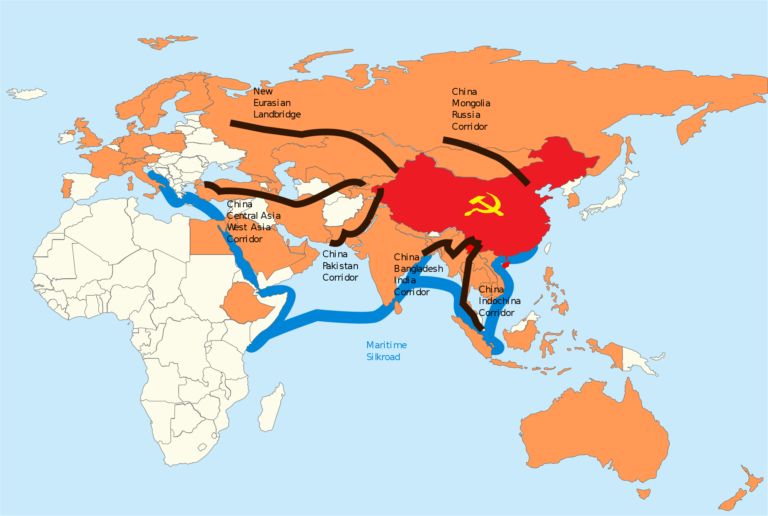One Belt, One Road Takes Center Stage
In 2013, the CCP officially introduced the plan for its Silk Road Economic Belt and Twenty-First-Century Maritime Silk Road, or One Belt, One Road (OBOR) for short. The plan is for the Chinese regime to invest billions and trillions of dollars to build critical infrastructure, such as bridges, railroads, ports, and energy generation in dozens of countries. OBOR is the biggest planned investment project in history.
One Belt refers to the Silk Road Economic Belt, which consists of three land-based components: from China through Central Asia and Russia to Europe and the Baltic Sea; from northwestern China through Central Asia and West Asia to the Persian Gulf and the Mediterranean; and from southwestern China through the Indochina peninsula to the Indian Ocean.
One Road refers to the Twenty-First-Century Maritime Silk Road, which is a two-pronged effort: The first route goes from the ports in China to the South China Sea, through the Strait of Malacca and on to Europe via the Indian Ocean; the second heads to the southern Pacific Ocean.
The One Belt on land consists of six economic corridors: the China-Mongolia-Russia Economic Corridor (CMREC), the New Eurasian Land Bridge (NELB), the China-Central and West Asia Economic Corridor (CCWAEC), the China-Indochina Peninsula Economic Corridor (CICPEC), the China Pakistan-Economic Corridor (CPEC), and the Bangladesh-China-India-Myanmar Economic Corridor (BCIMEC).
The New Eurasian Land Bridge will be based on rail links between China and Europe, called China Railway Express. Transportation from China to Europe by sea takes over thirty days, compared with just over ten days by rail. The China Railway Express began operation in 2011 and has been an important component in OBOR.
The China Pakistan-Economic Corridor (CPEC) is a joint plan by the two governments. It includes a highway connecting Kashgar in Xinjiang Province with the Gwadar Port in Pakistan, on the Indian Ocean. China gained the right to operate the port in 2013. Being Pakistan’s gateway to the Persian Gulf and Arabian Sea, the Gwadar Port occupies a critical strategic location. It connects to the Strait of Hormuz, through which 40 percent of the world’s crude oil passes to reach the Arabian Sea.
The general framework of the One Road by sea is to build a number of strategic ports and gain control over the sea transportation. In financially robust countries, Chinese companies enter into equity participation or joint ventures. With financially weaker countries, China invests large amounts of money locally and attempts to obtain the rights to operate the ports.
In 2013 alone, Chinese enterprises received the rights to operate at least seventeen ports or terminals. China Merchants Port Holdings Company Limited bought 49 percent equity from Terminal Link SAS in France. With this purchase, it obtained the operating rights to fifteen terminals in eight countries on four continents.[5]
These ports and terminals include the ports of Antwerp and Zeebrugge in Belgium; the Suez Canal Terminal in Egypt; Kumport in Istanbul, Turkey; the Port of Piraeus in Greece; Pasir Panjang Port in Singapore; the largest port in the Netherlands (Euromax Terminal Rotterdam, which is called “the gate of Europe”); the second-phase terminal at Khalifa Port in Abu Dhabi, United Arab Emirates; the Port of Vado in Italy’s Liguria region; Kuantan Port in the Strait of Malacca, Malaysia; the Port of Djibouti in eastern Africa; and the Panama Canal.
In addition to investment, the Communist Party also uses the debt traps created by OBOR to obtain control of strategic locations. Sri Lanka could not pay its debt to Chinese companies, so in 2017, it signed a ninety-nine-year lease with Chinese company for use of the Hambantota Port.
The CCP launched its Digital Silk Road in 2018 with the intention of reshaping the future development of internet infrastructure. The Digital Silk Road is considered an advanced stage in the OBOR project and is its newest development. It mainly includes building fiber optic infrastructure, digital information services, international telecommunications, and e-commerce.
Many countries involved in OBOR do not have a complete credit system. The CCP aims to introduce its systems of e-commerce and electronic payment services, such as Alipay, to these countries, while totally shutting out Western competition. The Great Firewall, which filters internet traffic in China, is being exported to the countries of the Belt and Road, as are the systems of mass surveillance already adopted by the CCP for use within China.
The extent of the CCP’s strategic reach can be seen from its investment in global infrastructure. According to a November 2018 report by The New York Times, the CCP has constructed or is constructing over forty pipelines and other oil and gas infrastructure, over two hundred bridges, roads and railways, almost two hundred power plants for nuclear power, natural gas, coal, and renewables, and a series of major dams. It has invested in 112 countries, most of which belong to the OBOR initiative. The CCP has spread its tendrils around the globe.[6]
As OBOR took shape, the CCP’s efforts to supplant the United States on the world stage swelled. It aggressively promoted the yuan as an international currency, as well as its own credit system. Chinese-made telecommunications networks (including 5G) are being pushed as the future in many countries, as are Chinese-built high-speed rail lines. The aim is to eventually establish a set of standards controlled by the CCP and independent of the current Western standards.[To be continued]
From Chapter Eighteen
The Chinese Communist Party’s Global Ambitions

One Belt, One Road(OBOR)

